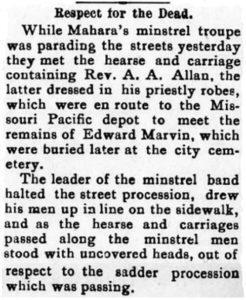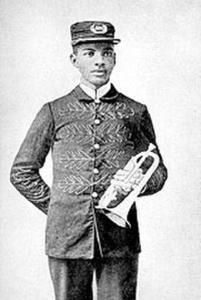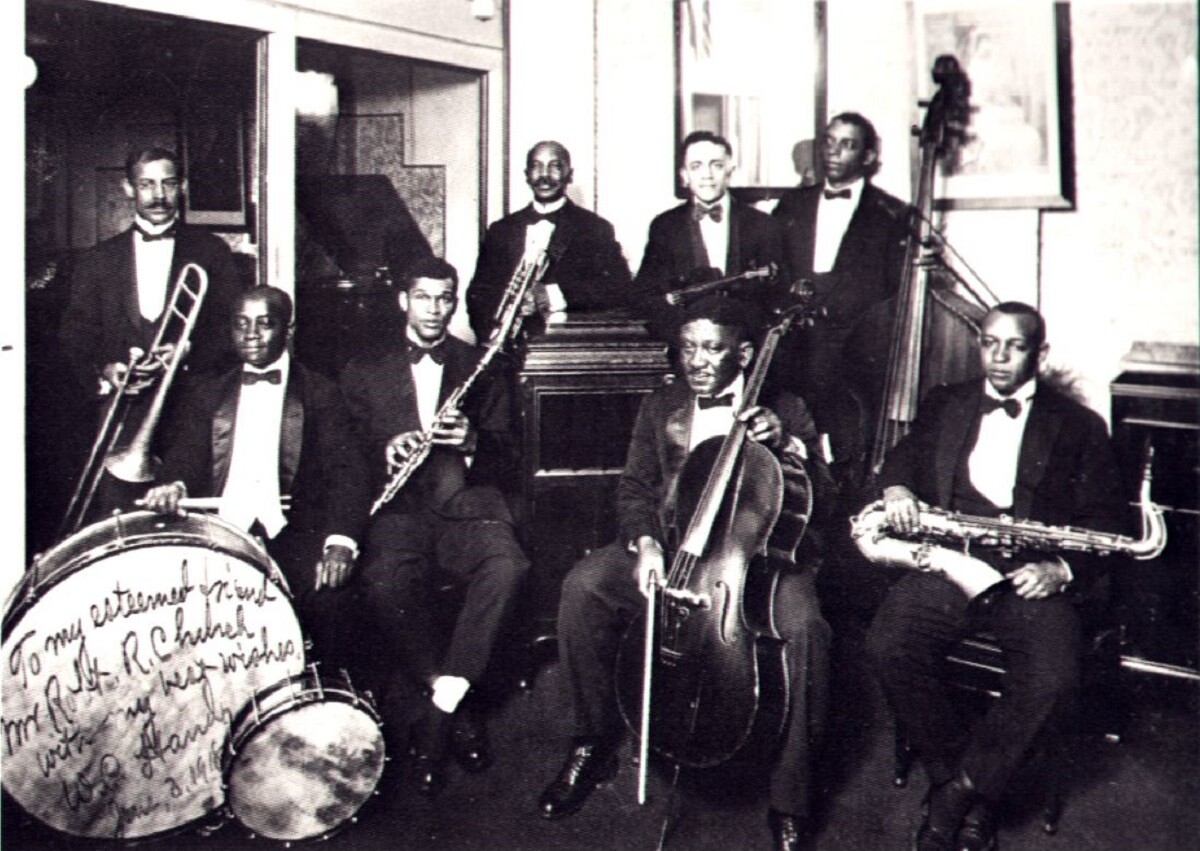This month I am going to use this tiny Sedalia newspaper snippet from 1902 to discuss some thoughts on research and then segue to writing about another important letter I received from Charles Hanna this week. First, the article…
In researching Sedalia during the ragtime era, I came across this article while going through old newspapers in the basement of the city’s Carnegie Public Library in the early 1970s and copied it. I have recently been communicating with Elliott Hurwitt about the biographical work he is doing, and I remembered the old article I had kept. Hurwitt had mentioned his subject had worked as bandleader for the Mahara Minstrels about the time of the incident. It occurred to me that the unnamed leader of Mahara’s band who so poignantly acknowledged the funeral procession that day, could be the same person.
 I was suddenly also in awe of modern researchers (this happens to me often) when I realized it is one thing to search for information by a keyword or name, but it is also necessary to have sufficient knowledge of a subject to derive a significant detail from indirect information. Hurwitt validated that his subject was the Mahara bandleader on that date and thus I can visualize a young W.C. Handy standing respectfully on the sidewalk as his troupe observed the sad procession passing. (This seems a fitting vignette to inspire a composition, that the Father of the Blues might have written, perhaps it might have been “The Sedalia Sidewalk Blues.”)
I was suddenly also in awe of modern researchers (this happens to me often) when I realized it is one thing to search for information by a keyword or name, but it is also necessary to have sufficient knowledge of a subject to derive a significant detail from indirect information. Hurwitt validated that his subject was the Mahara bandleader on that date and thus I can visualize a young W.C. Handy standing respectfully on the sidewalk as his troupe observed the sad procession passing. (This seems a fitting vignette to inspire a composition, that the Father of the Blues might have written, perhaps it might have been “The Sedalia Sidewalk Blues.”)
Handy had joined Mahara’s Minstrels in 1896 and the following year became the leader of the troupe’s 30-piece parade and 42-piece orchestra bands. Minstrel show parade bands were a vital part of a troupe’s appearance while they were in a town. They would march flamboyantly through the streets and put on a show to attract an audience for the evening performances. They wore spiffy outfits, had a dazzling drum major and of course a well-attired director, all as described in Handy’s autobiography, Father of the Blues.
Imagine then, this parade band in grand regalia, at full stride, playing a peppy march, strutting down Ohio Street and about to the run head-on into the funeral cortège. Handy must have made a hasty decision to abruptly halt his band’s festive progress and move his men to the sidewalk as the funeral vehicles approached. He probably passed the word down the line to uncover heads in respect in the process.

I also want to pursue the fact that Mahara’s show grew out of the McCabe and Young Minstrels because Dan and William McCabe were once Sedalia residents and it is likely that there were some Sedalians in the troupe. After McCabe had trouble leaving Mexico in 1892 McCabe’s, agent W.A. Mahara reorganized the group as Mahara’s McCabe & Young Minstrels.
W.C. Handy left Mahara’s in 1904 to briefly teach at Alabama A & M College before going on to become the famous blues composer and orchestra leader.
There is at least one other incident when Handy was in Sedalia related by Tom Ireland. Handy died in 1958. While Ireland was working at The Sedalia Democrat, he recounted taking Handy to the Maple Leaf Club Room while the composer was in town (see TST, December 2017,) to get acquainted with the boys and set in with the band. This may have been during the 1902 visit since there was no mention of Joplin who was in St. Louis by then.
During Brun Campbell’s campaign to fire up Sedalia about its musical heritage, Campbell had recruited Handy to write a letter to the Sedalia paper in 1950 encouraging special recognition for Joplin and Sedalia’s role in American music. (TST April 2018, p. 8.) Charles Hanna wrote in his April 2, 1950 “Music Modes” column in the Sedalia Democrat, that Handy had written that it would be, “appropriate if some form of memorial were to be dedicated to Joplin.” Handy went on to say how important Joplin’s music had been to his own work and that since Memphis had dedicated a square and theater to him for writing the blues, Sedalia should do the same for Joplin.
That article coupled with a three-page typescript letter Hanna received as a part-time reporter in Great Falls, Montana, further emphasizes Handy’s appreciation for Joplin’s contribution. He describes Joplin’s work as “indescribable masterpieces of ragtime music.” Handy refers again to Joplin’s influence on him and states that he was, “aspiring to reach the heights of the classics [and] always something happened to make [him] see the beauty and virility in American music, especially syncopation.” He went on the say that Joplin was at least 25 years ahead of his time.

Handy’s long letter to Hanna seems typical of the old composer’s correspondence, at least in his later years. Other Handy letters available on-line all address a similar theme. Handy, like Joplin had a career impacted by racial bias as well as a negative attitude from both races against ragtime, the blues, and minstrelsy. Handy takes every opportunity to promote the attributes of his generation of original American composers and their music. He was fortunate to live long enough to receive many honors and adulations that Joplin did not get to enjoy and Handy seems acutely aware of that injustice.
Since this turns out to be about Handy and Joplin, I must remark about their other unusual connection that is still shrouded in mystery as far as I know. The piano roll of “Ole Miss Rag” by W.C. Handy that Scott Joplin supposedly cut in 1916 is a puzzlement and little is known about it. Speculation involves a relationship between the men, Joplin’s respect for Handy and/or the composition, or even fraud is suggested by a few. Perhaps we will never know. In my stamp collection, I have the Joplin stamp First Day Cover with a W.C. Handy stamp cancelled with it. That’s a firm connection I can make between the two great composers.
Thanks to these newspaper articles and Charles Hanna’s letter, I have a better image of W.C. Handy and appreciate that he tried to elevate Scott Joplin’s reputation and the importance of ragtime. Check out the new documentary on Handy’s life and career titled Mr. Handy’s Blues: A Musical Documentary directed and produced by Joanne Fish, including commentary by Elliott Hurwitt at www.mrhandysblues.com.
Larry Melton was a founder of the Scott Joplin Ragtime Festival in 1974 and the Sedalia Ragtime Archive in 1976. He was a Sedalia Chamber of Commerce manager before moving on to Union, Missouri where he is currently helping to conserve the Ragtime collection of the Sedalia Heritage Foundation. Write him at lcmelton67@gmail.com.






















